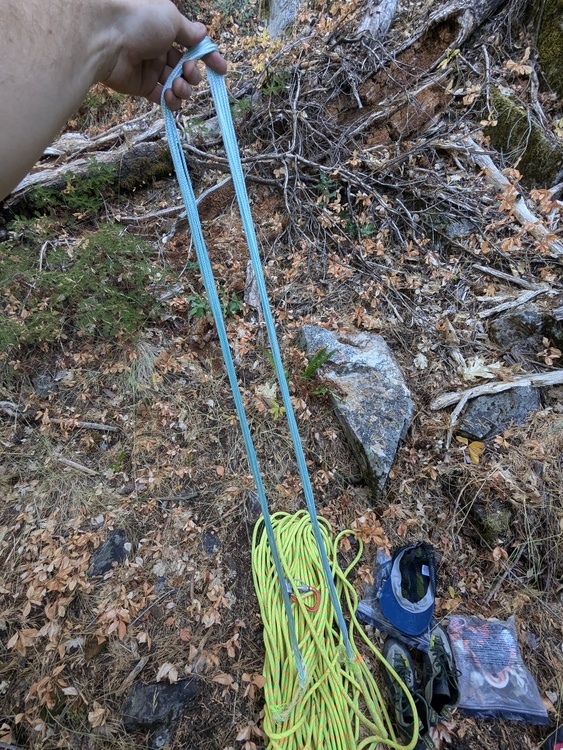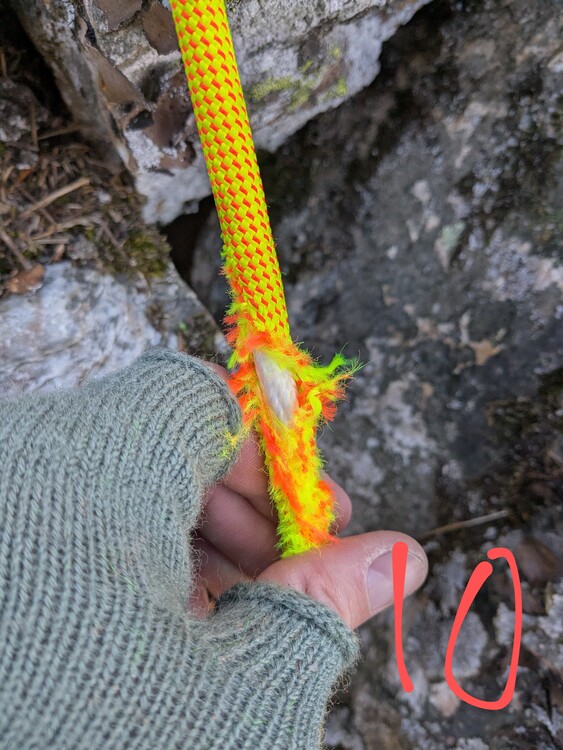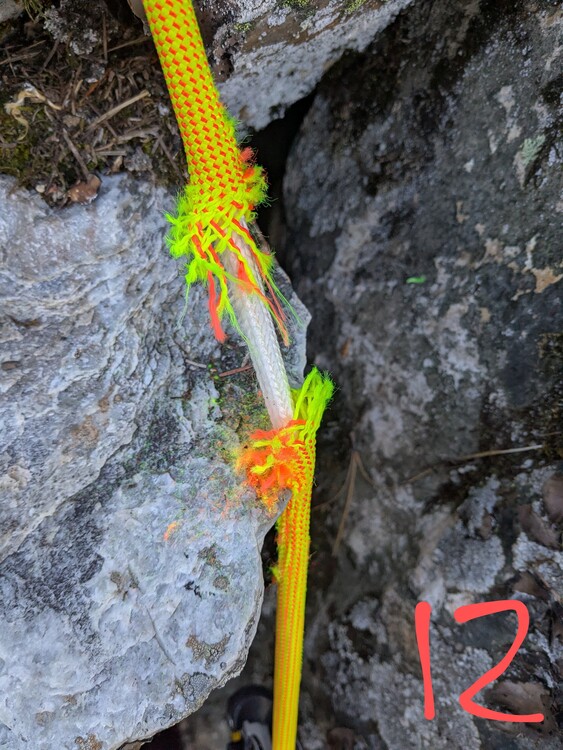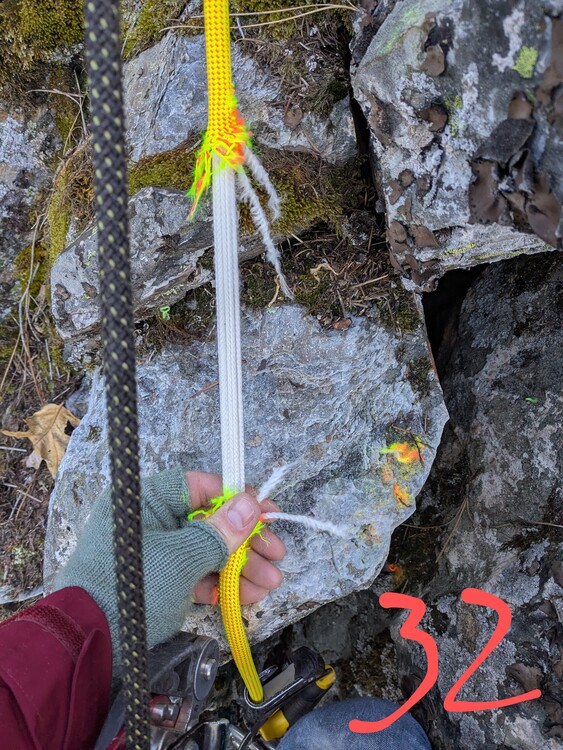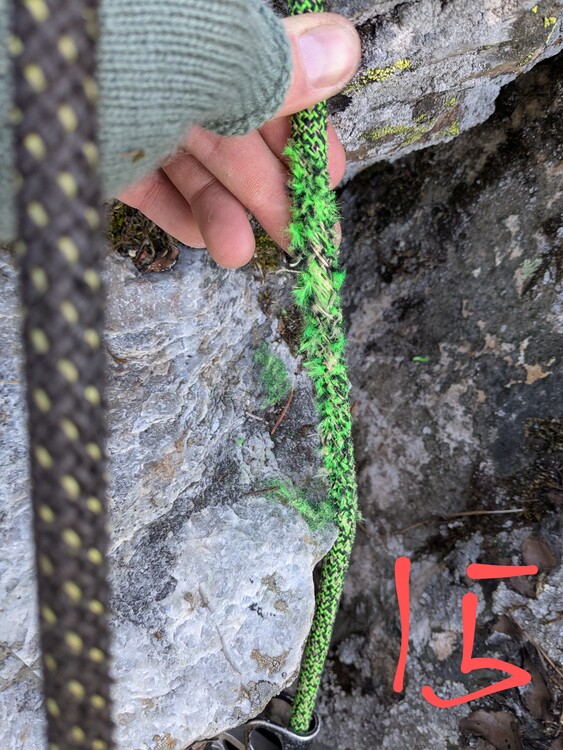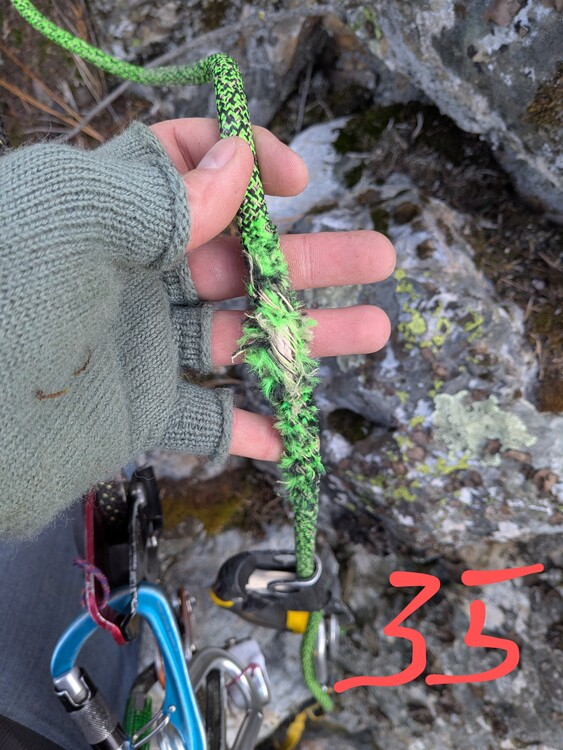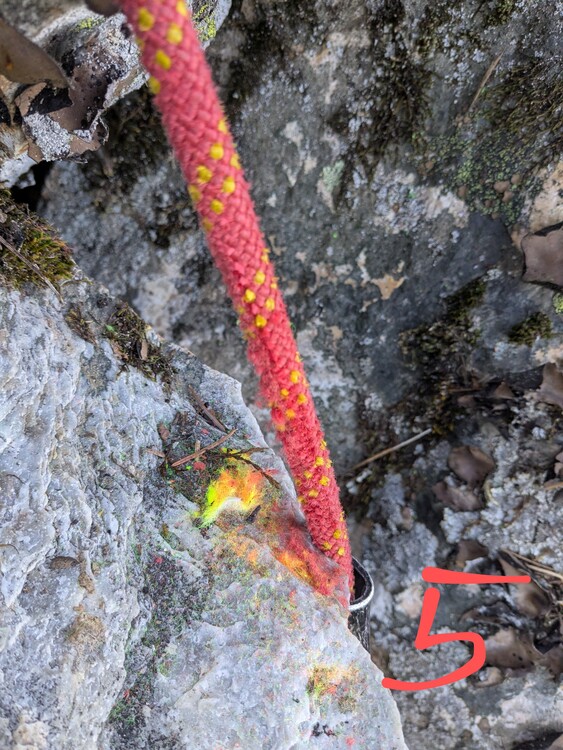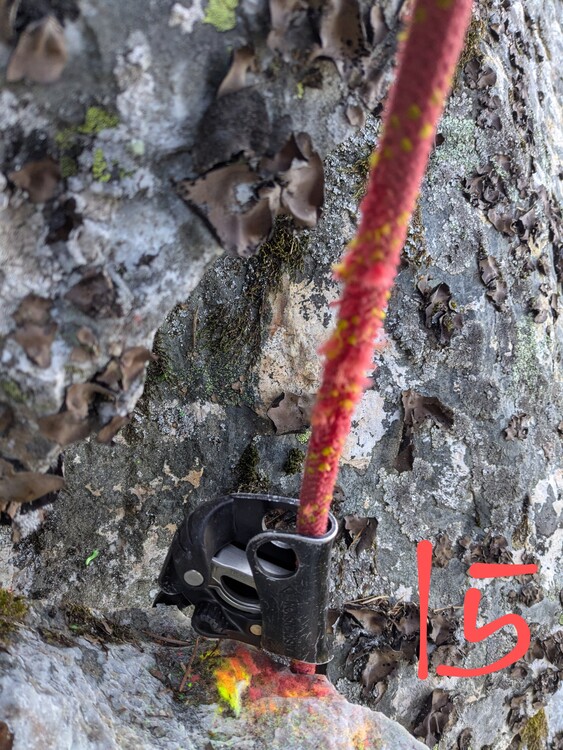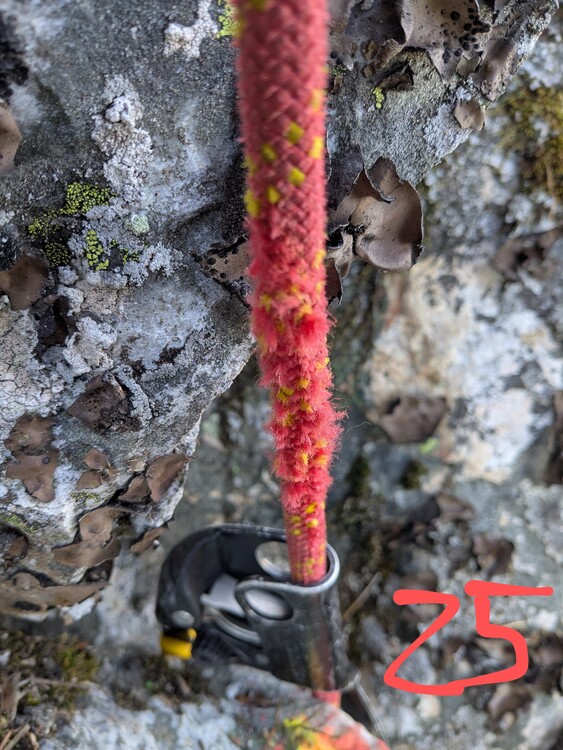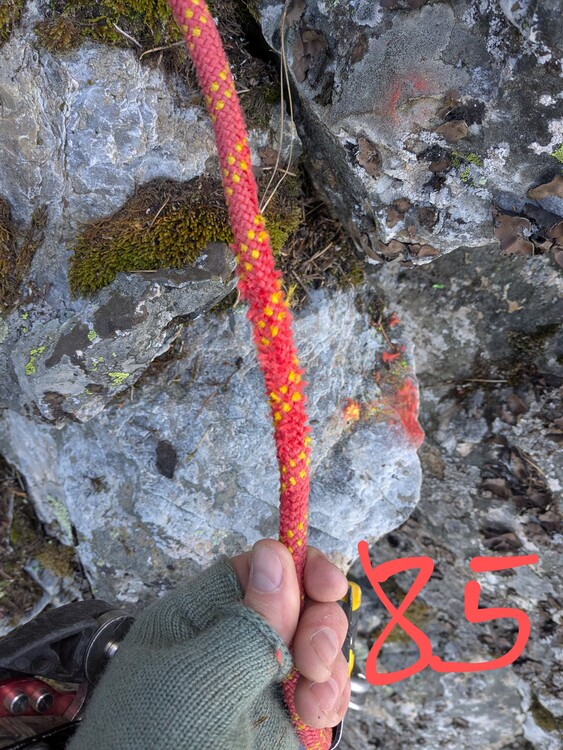Extremely unscientific rope sharp edge testing on extremely sharp quartzite: normal rope vs. Edelrid 8.9 protect pro vs. static rope
|
|
While putting up a new trad route with a buddy, my buddy's brand new Mammut Alpine Core Protect rope got its sheath cut while I was on follow. There was some interest about doing testing of different ropes on this edge, so I went out and did some extremely unscientific (N=1) testing yesterday. This edge is SHARP, and although I didn't get as high as this edge when I climbed it that day, it was really easy to find as it still had lots of rope fuzz on it and all around it. My testing procedure was that I was on a fixed line, then I would have several feet of rope to test attached to a jumar on the fixed line. Another jumar with a foot loop on the bottom of the test rope allowed me to stand in it and load it over the edge. I slowly weighted it fully and used one of those ticker counter thingies to track how many times I loaded the rope. I am currently a chonky boi from not climbing or doing much last year and probably weigh in around 230 lbs. Here are the results for three different rope types: First up is a typical dynamic rope, the IonR 9.4mm Xeros. After five loads over the edge it had significant sheath damage: After ten loads on the edge the core was showing: After 12 the sheath got cut: It took significantly more to get to core damage. After 25 loads we start seeing significant core fraying: After 32 loads two of the core strands popped: Let's compare the Edelrid 8.9 Swift Protect Pro. Sheath took way more of a beating, and is fucked up but no core exposed at 15 cycles: At 25 cycles it's starting to peek some core out, but there's still a lot of sheath coverage: Finally at 35 cycles the core is fully exposed: I stopped testing here, as I figured once the core is exposed I reckon the core will pop similarly to the previous rope. Lastly, for shits and giggles I tested a static rope. This is the Bluewater Haul Line 9.5mm rope. This is specifically designed to be a haul line and it has a 50% sheath percentage which is the highest of any rope I know of, so this test is not necessarily representative of all static ropes as this is not a typical static rope. At 5 loads there was some fuzz on the rock, but the rope was looking astonishingly good: At 15 it was clear this thing is a beast: For the next ten loads for some reason it started spinning and so was spreading the wear out over multiple sides of the rope: So I played with it a bunch over a few more cycles, trying to figure out how to get it to not rotate on me. I didn't get a picture of 35, but that's where I figured out how to get it to stop spinning on me. After then finding the way to load it so that it would stop spinning on me I then proceeded to load it FIFTY times. At this point my foot was hurting and I was shredding my foot loop and I decided to go home. |
|
|
Good write up, appropriate thread, adequate photos. Bravo! |
|
|
Sweet! I have that same Bluewater Haul Line. Have put it over lots of edges, but mostly in softer sandstone. Still kinda stiff and hard to pack down, but glad to see it's as beastly as it feels. |
|
|
This is awesome! Good to know that cut resistant sheath really does make a difference. I assume Edelrid's technology is similar to Mammut's "core protect" technology? I'm curious to see a similar experiment that compares these new "cut resistant" sheaths to a Beal unicore rope. |
|
|
Avram Neal wrote: The edelrid rope has the aramid fibers woven into the sheath itself, the Mammut rope has a normal sheath with its cut resistant fibers in a mini sheath under the normal sheath. I hypothesize that the Edelrid tech is superior but I cannot confirm that without more testing. I have a unicore rope but I need it to remain a 70. If anyone wants to send in a few meters of unicore rope I'll happily test it. Or any other rope that is of interest to people for that matter. |
|
|
thanks for the interesting write-up. i use my wife's old BW haul line for TRS. it has million miles on it, and it is as stiff as a board. i keep thinking i am going to retire it, but then i just take it out for one last day, over and over. tough rope. |
|
|
Excellent little exposé Ricky! |
|
|
Significant sheath damage from a top rope? Scary. Imagine what could happen on lead. Good thing ropes are redundant! Wink. |
|
|
It’s cool to see some real application of the edelrid rope. I absolutely love mine and know how cut resistant it is, or believe it to be, but this is great anecdotal evidence. |
|
|
Ricky Harline wrote: This is obviously troubling but more details needed please. On the follow, were you taking repeated falls at one spot and on the rope? If so, how many falls, and how much time did you spend as dead weight? Was he yarding in rope while under semi- tension etc. kind of helping you through that one spot? I'm assuming it was one spot otherwise there might have been multiple places of damage? Or was the follow completely clean? |
|
|
Heyzeus wrote: Sure. So it was a hard for me route (overhanging thin hands, bleh) and the third or fourth piece had walked back into the crack. I asked my leader who was up at the anchor to take so I could rest on the rope and use both hands to remove the piece. He tried to take but the rope wouldn't go up. I tried hanging on the rope but I was too far below to the piece to reach it. He tried to take a few more times and I rested on it a few more times trying to reach the piece, and then he called down in a very panicked voice that the rope was damaged and I needed to build a mid pitch anchor. This was six months ago or so and I don't recall how many times I rested on the rope. At least three times, less than six I reckon. Was NOT a good time fun party, but was a lot better than the previous week when my leader had his (well my) rope's sheath cut mid lead on P1 of a 3 pitch trad FA. Those were the fourth and fifth ropes to get cut out there, but the previous three were all fixed ropes where the damage could have been prevented. Quartzite don't play. |
|
|
The part I find hardest to believe is that you are up to 230#. You’ve been eating good! Also, love to hear the BW ropes took a good beating. |
|
|
Ricky Harline wrote: That's a lot of ropes getting cut and sure would freak me out. Are you guys hammering down these edges? Or are they too plentiful and just the nature of the rock? |
|
|
|
|
|
I think the unicore cover will shred as easily as as a regular nylon rope, it would last longer if testing until it breaks, but some adhesive on the core wouldn’t help with the cut resistance of the cover. |
|
|
Yeah i understand what you mean, but from all other testing videos ive seen, the sheath opens up on regular ropes, and then once the corse is exposed things go very quickly from there, the core doesnt seem very resitant to abrasion, i feel with unicore rope, you would get similar sheath damage but it would still take much longer before the core strands get exposed.... Its not really about the sheath getting shredded, but more about the fact that the sheath sort of stays in place instead of bunching up and letting the core strands getting rubbed on the sharp edge i would think |
|
|
Thanks Ricky - this is awesome. I will continue to TRS on statics! Will you post this to the FB TRS forum? |
|
|
damn that is crazy how fast that went through a standard rope, thanks for the writeup! |
|
|
Charles Winstead wrote: lol I like ice cream and beer a lot, and when I get really tired I like them even more... I'm starting to lose the weight now but it's gonna take a while, I packed on quite a few pounds. Being a tall ass dude I can put on 40 or 50 lbs pretty easily and it doesn't look like so much. But I'm definitely keen to get back down to sending weight! Heyzeus wrote: So yeah we're going to figure out solutions for these two routes where the ropes got cut. For the route that cut the Mammut Alpine Protect rope I think we're going to install a bolt that keeps the rope far from the edge. In part I don't want to hammer the rock, in part hammering quartzite doesn't work out so good. There are rocks harder than quartzite but they don't generally form in large formations, meaning quartzite is the hardest rock you can climb, really. It is considerably harder than granite. I tend to get about one eighth to one quarter of the bolt holes when drilling that you do in granite, for example. For the multipitch I need to figure out what happened because the rope got desheathed in a finger crack somehow, so I'm not sure how to fix it, but that route's also only been climbed the once so I need to revisit it and come up with a solution. If you're climbing any of our developed routes it isn't really a problem, but if you're doing a ground up trad FA you never know what you'll find, and you might find some rope-shredding rock. I think I will be using my Edelrid rope for ground up FAs out there from now on. Jay Anderson wrote: You can't really post photos inline on FB the way that you can on MP so it won't be as readable, but if you think it would be a valuable contribution I don't mind posting it there also. |
|
|
Great test data! One note - Since you only have a sample size of one of each of the three ropes, it is possible that the order of testing will make a difference. Or , if you were starting over, use a trash rope first to wear in the sharp edge to the condition where it starts to stabilize in sharpness. All this is just a guess that might help with repeatability. |
|
|
Yeah, this is super valuable information for me as I’m doing a lot of TRS on quartzite in the desert and thought using a dynamic rope, especially on a single strand was not wise. Glad I got a static! |

 Continue with onX Maps
Continue with onX Maps Sign in with Facebook
Sign in with Facebook

















